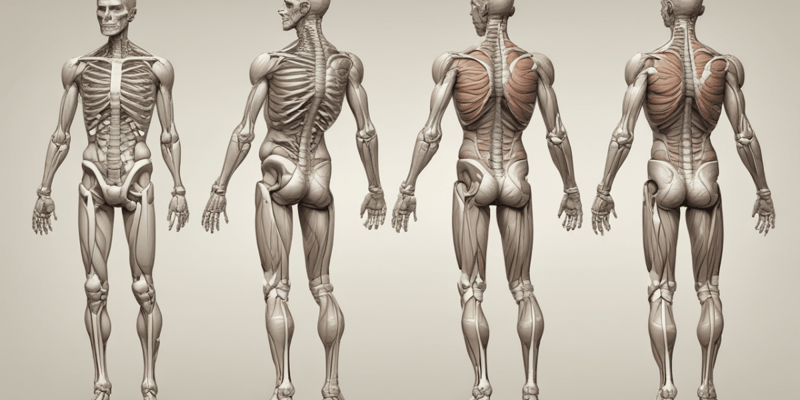Questions and Answers
Which type of joint allows for the most movement?
What is the primary function of synovial fluid?
Which of the following joints is classified as a fibrous joint?
Which type of joint is primarily described as semi movable?
Signup and view all the answers
Which joint is specifically an example of a synovial joint?
Signup and view all the answers
What are bursa sacs filled with?
Signup and view all the answers
Which of the following best describes the role of phagocytes within synovial fluid?
Signup and view all the answers
Which type of joint provides the greatest range of motion?
Signup and view all the answers
What is the primary movement of a hinge joint?
Signup and view all the answers
Which joint is specifically designed to allow movement similar to grasping small objects?
Signup and view all the answers
What distinguishes a gliding joint from other types of synovial joints?
Signup and view all the answers
Which movement is described as moving a body part towards the midline?
Signup and view all the answers
In which joint does the dens of the second cervical vertebra allow rotation?
Signup and view all the answers
What is the process of decreasing the angle of a joint called?
Signup and view all the answers
What does plantar flexion involve?
Signup and view all the answers
Which movement involves a body part moving in a circular path?
Signup and view all the answers
Which of the following best describes hyperextension?
Signup and view all the answers
Which joint is characterized as having the greatest range of motion?
Signup and view all the answers
Which joint is classified as a ball-and-socket joint?
Signup and view all the answers
What type of joint is the elbow primarily classified as?
Signup and view all the answers
Which of the following describes the largest joint in the human body?
Signup and view all the answers
Which joint involves the articulation between the humerus and scapula?
Signup and view all the answers
Which joint structures allow for the complex movement of the knee?
Signup and view all the answers
The humeroradial joint connects which of the following bones?
Signup and view all the answers
Which joint is specifically associated with the articulation between the humerus and ulna?
Signup and view all the answers
What establishes the articulation of the largest and most complex joint in the human body?
Signup and view all the answers
Which joint allows for the highest degree of mobility in the human body?
Signup and view all the answers
Study Notes
Joints Overview
- Joints, or articulations, are points where bones meet; some joints are immovable, while others allow considerable movement.
- Essential for body movements: walking, running, dancing, and typing.
Types of Joints
Fibrous Joints
- Also known as synarthroses, fixed joints as collagen fibers penetrate and anchor adjacent bones.
- Example: Skull sutures, which are fibrous joints in the adult skull.
Cartilaginous Joints
- Known as amphiarthroses, these joints are semi-movable, connected by cartilage.
- Example: Intervertebral discs, which provide flexibility and support.
Synovial Joints
- Identified as diarthroses, these joints are freely movable and the most common type in the body.
- Contain synovial fluid, a viscous lubricant that nourishes cartilage and helps remove debris via phagocytes.
- Bursa: Small sacs filled with synovial fluid reduce friction and enhance movement.
Naming Conventions for Joints
- Named based on the bones involved:
- Humeroscapular joint (humerus and scapula)
- Temporomandibular joint (mandible and temporal bone)
- Sacroiliac joint (sacrum and ilium)
Types of Synovial Joints
- Ball and Socket Joint: Maximum range of motion; examples include shoulder and hip.
- Pivot Joint: Allows rotational movement; example is the dens of the cervical vertebrae.
- Hinge Joint: Permits bending and straightening; includes elbow and knee.
- Saddle Joint: Unique to thumbs, allows opposable movement.
- Condyloid Joint: Allows movement in multiple directions, found in wrist and finger joints.
- Gliding Joint: Minimal movement; found in tarsal bones and carpal bones.
Movements of Synovial Joints
- Flexion: Decreases the angle of a joint.
- Extension: Increases the angle between bones.
- Hyperextension: Extreme extension beyond the normal position.
- Dorsiflexion: Elevates toes or foot upwards.
- Plantar Flexion: Lowers toes or foot downwards.
- Abduction: Moves a body part away from the midline.
- Adduction: Moves a body part towards the midline.
- Circumduction: Circular movement of a limb.
- Internal Rotation: Rotates a bone towards the body's midline.
Key Synovial Joints Requiring Medical Attention
- Shoulder, elbow, knee, and hip are frequently involved in injuries.
Specific Joint Details
Shoulder
- Humeroscapular joint and glenohumeral joint (articulation between the head of the humerus and glenoid cavity of scapula).
- Greatest range of motion of any joint.
Elbow
- Comprised of humeroulnar joint (between humerus and ulna) and humeroradial joint (between humerus and radius).
- Functions as a hinge joint.
Knee
- Tibiofemoral joint is the largest and most complex joint in the body.
Common Injuries and Conditions
- Shoulder Dislocation: Most likely joint to dislocate.
- Knee Injuries: More frequent due to fewer surrounding muscles; common in athletics.
- Meniscus and ACL: Structures commonly injured in the knee.
- Cartilage Healing: Slow due to lack of blood supply.
-
Arthritis: Inflammation of joints, can take the form of:
- Osteoarthritis: Most prevalent; results from wear and tear affecting various joints.
- Rheumatoid Arthritis: Autoimmune disorder attacking synovial membranes, causing pain and deformity.
Surgical Interventions
- Arthroplasty: Surgical replacement of a diseased joint with an artificial device; commonly performed on hip and knee joints.
Studying That Suits You
Use AI to generate personalized quizzes and flashcards to suit your learning preferences.
Description
Explore the different types of joints in the human body with this quiz focused on Chapter 9 of your anatomy studies. Discover the definitions, characteristics, and examples of immovable and movable joints including fibrous and cartilaginous joints. Perfect for reinforcing your understanding of skeletal structures.




